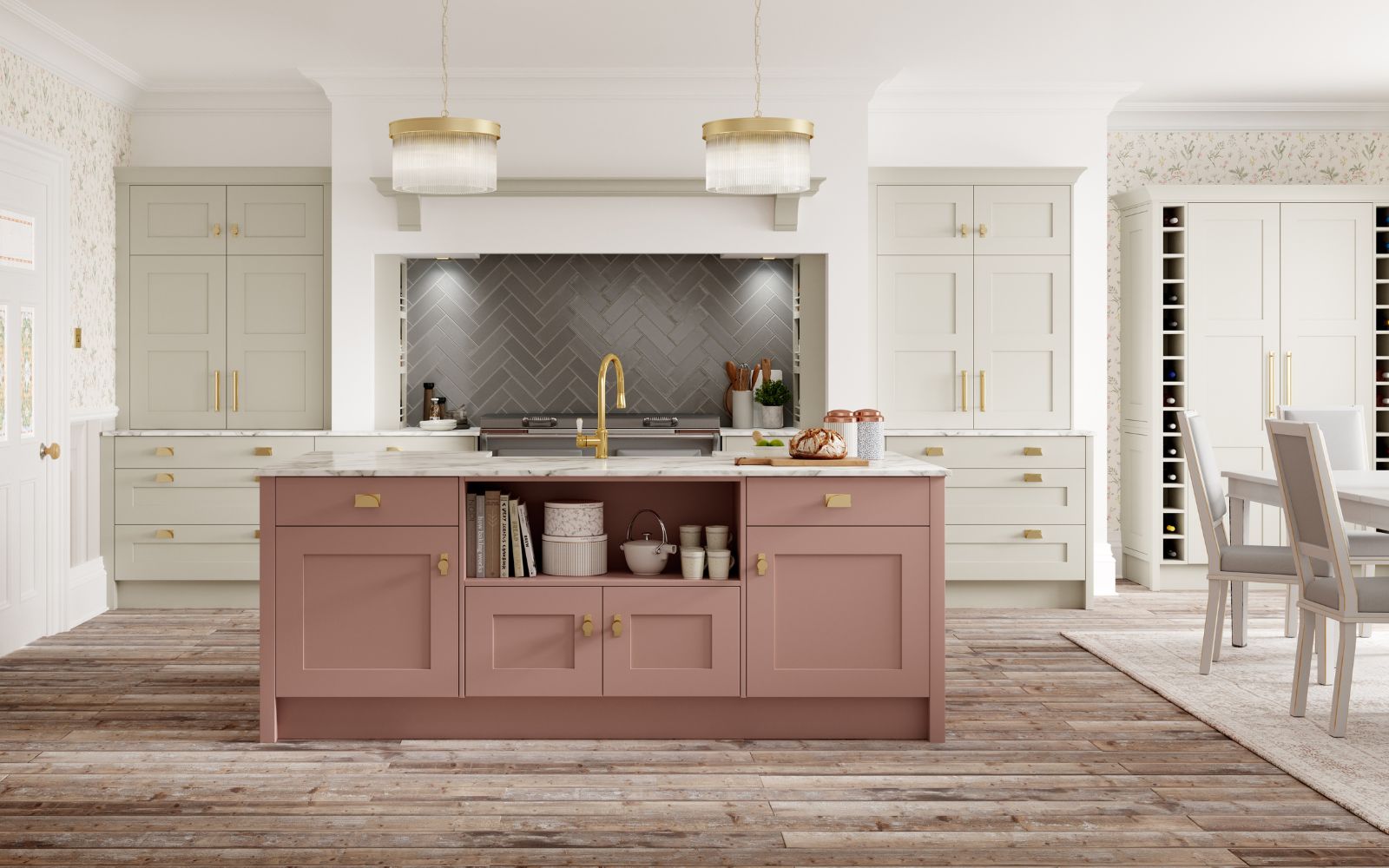Shaker kitchens
The Shaker style is known for its framed doors, symmetrical lines, and use of open shelving. When designing a kitchen in this style, you can opt for a clean, minimalist look or embrace a more traditional Shaker aesthetic. Build a shaker kitchen with MP MORAN.
Our range of Shaker kitchens:
What Is a Shaker Kitchen?
Looking for a kitchen style that’s timeless, elegant, and works in almost any home? The Shaker kitchen might be exactly what you’re after.
A Shaker kitchen is known for its simple, clean design: flat cabinet doors with a square frame and a recessed centre panel. Inspired by 18th-century craftsmanship, Shaker style focuses on function, durability, and understated beauty — making it a favourite for both classic and modern interiors.
What makes it so popular today? Shaker kitchens are incredibly versatile. You can dress them up with brass handles, marble worktops, and neutral colours for a traditional look — or modernise them with bold shades, sleek appliances, and smart storage. Whether you’re a homeowner planning a renovation, an interior designer curating a show home, or an architect designing a new build, a Shaker kitchen offers style that truly lasts.
What Does a Shaker Kitchen Look Like?
A true Shaker kitchen is instantly recognisable by its framed cabinet doors—a flat recessed panel surrounded by a clean square edge. This frame is built with vertical “stiles” and horizontal “rails” for strength and symmetry. You’ll also often find wooden knobs, peg rails, and high-quality dovetail joinery inside the drawers.
While traditional Shaker kitchens were made from natural hardwoods and left unpainted or finished in muted colours, modern versions come in a wide range of paint colours, finishes, and materials to suit every home.
A Brief History: Who Were the Shakers?
The Shakers were a Christian community in 19th-century America, known for their simple living, communal values, and incredible craftsmanship. They built everything by hand—from buildings and tools to chairs and kitchen furniture—with a strong focus on honesty, sustainability, and long-lasting quality.
They believed in using locally sourced hardwoods like maple and cherry, often leaving furniture unpainted or using earth-tone paints in red, yellow, or blue. Their goal was to avoid waste and build with care—values that are more relevant than ever in today’s kitchen design world.
Why Are Shaker Kitchens Still So Popular?
Shaker kitchens have stood the test of time for many reasons:
-
✅ Timeless Design – Their simple, clean style never goes out of fashion.
-
✅ Highly Practical – Designed for real-life use with smart kitchen storage solutions.
-
✅ Customisable – Choose from a wide range of cabinet colours, handles, and worktops.
-
✅ Sustainable – Originally crafted from natural wood, the Shaker ethos aligns with modern eco-conscious design.
-
✅ Versatile – Perfect for any kitchen layout—from cosy cottages to modern apartments.
Whether you’re planning a kitchen renovation, working with a designer or architect, or exploring bespoke kitchen furniture, a Shaker kitchen provides a timeless foundation.
FAQs – Shaker Kitchens
1. What is a Shaker kitchen?
A Shaker kitchen is a style of cabinetry featuring simple, clean lines with a square frame and recessed centre panel. It’s inspired by the Shaker movement of the 18th century, which valued craftsmanship, functionality, and minimalism. Today, it’s one of the most versatile kitchen styles—easily adapted to both traditional and modern homes.
2. What is the difference between a Shaker kitchen and a traditional kitchen?
Shaker kitchens are minimalist and symmetrical, with flat-panel doors and clean frames. Traditional kitchens, on the other hand, often feature more ornate details, raised panels, curved lines, and decorative mouldings. Shaker design focuses on simplicity and balance, while traditional kitchens lean into elegance and detailing.
3. Why are kitchens called Shakers?
The term “Shaker” comes from the Shaker religious community, known for their dedication to simplicity, honesty, and high-quality craftsmanship. They designed furniture and cabinetry with minimal decoration and maximum function. The Shaker kitchen carries forward this timeless, practical design philosophy.
4. Are Shaker cabinets going out of style in 2025?
No, Shaker cabinets are not going out of style in 2025. In fact, they remain one of the most popular choices because of their clean lines, adaptability, and timeless appeal. They can be easily updated with modern colours, finishes, or hardware to stay current with design trends.
5. Are Shaker kitchens dated?
Shaker kitchens are considered classic rather than dated. Their simplicity makes them easy to personalise with new materials, colours, and finishes. By combining Shaker cabinets with modern worktops, lighting, and appliances, you can create a timeless yet fresh space.
6. What are the six types of kitchens?
The six main kitchen layouts are: one-wall, galley, L-shaped, U-shaped, island, and peninsula. Each layout serves different space needs and lifestyles. Choosing the right one depends on your room size, storage needs, and how you use your kitchen day-to-day.
7. What is replacing Shaker cabinets?
While Shaker cabinets remain a top choice, slab-front cabinets (flat, handleless doors) and skinny Shaker styles are becoming more popular in modern homes. These offer a sleeker, more contemporary look while keeping some of the Shaker appeal. Textured and mixed-material cabinetry is also on the rise.
8. Is Shaker style farmhouse?
Shaker style and farmhouse style often overlap but are not the same. Shaker design is more minimal and structured, while farmhouse style includes rustic elements like open shelving, distressed finishes, and natural textures. Many modern farmhouse kitchens use Shaker cabinets as a base for their clean look.
9. What is a skinny Shaker kitchen?
A skinny Shaker kitchen uses cabinets with a thinner frame profile than the classic Shaker style. This creates a more modern, streamlined look while maintaining the framed door structure. It’s a popular choice for those who want a blend of traditional and contemporary design.





